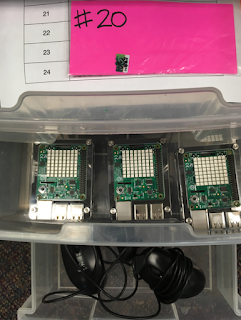We only have enough resources for seven Raspberry Pi computers. Students are required to collaborate and be able to work with others in pairs or groups of three for each project. This is beneficial in helping the students through the new concepts and making them more comfortable with coding. By the end, my goal is that all students appreciate and have a basic understanding of coding. They should feel that coding is something doable.
How do I organize the components for the computers?
 Monitors: Cords wrapped around screen and placed on shelf
Monitors: Cords wrapped around screen and placed on shelfKeyboards: Stacked on shelf
Mice: Stored in a drawer
Power Cord: Stored in a drawer
Raspberry Pi: Stored in a drawer
microSD cards: Cards are labeled with a number and placed in a bag labeled with the same number along with a piece of numbered card stock color coded by class. In the drawer is a sheet of paper which lists the classes and each group’s assigned microSD number.
Each group of students has their own microSD card, making it seem as if the computer was actually theirs. This cuts back on the potential issue of work disappearing between classes and allows students to take risks such as installing programs or changing settings as time allows.